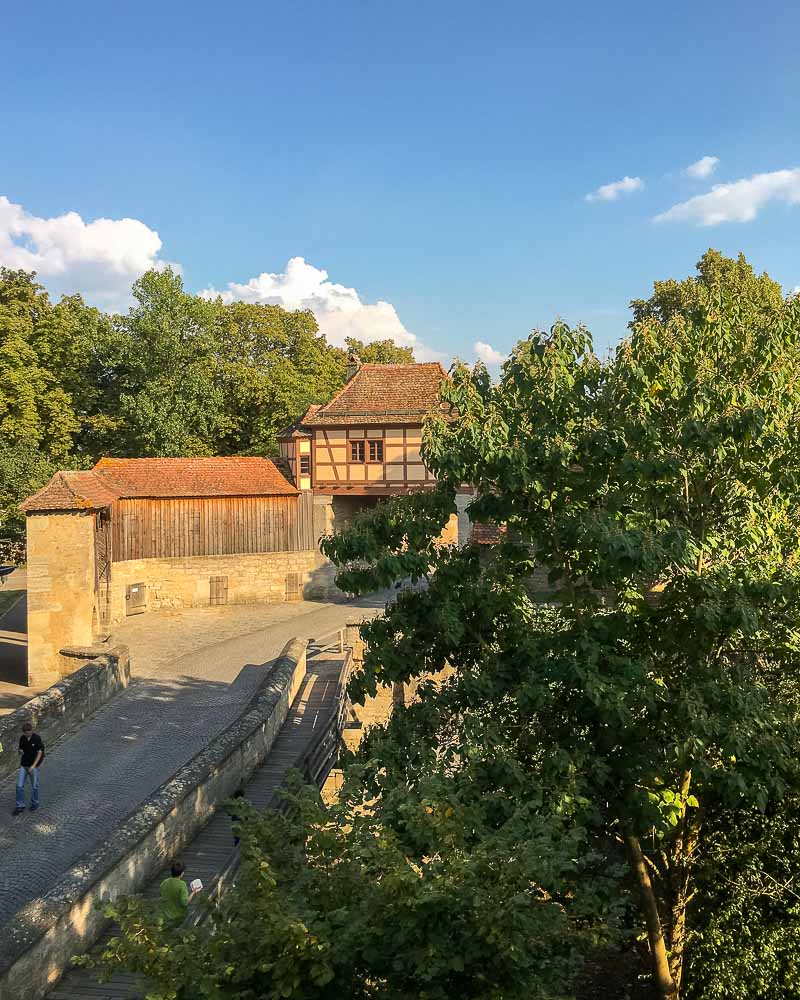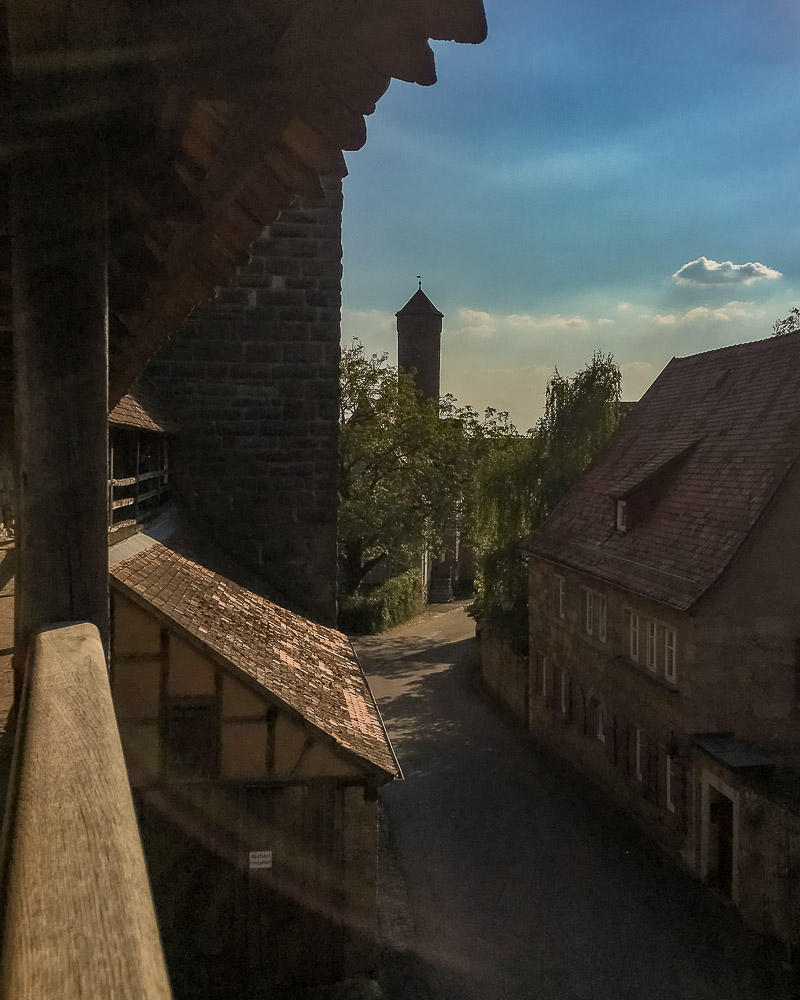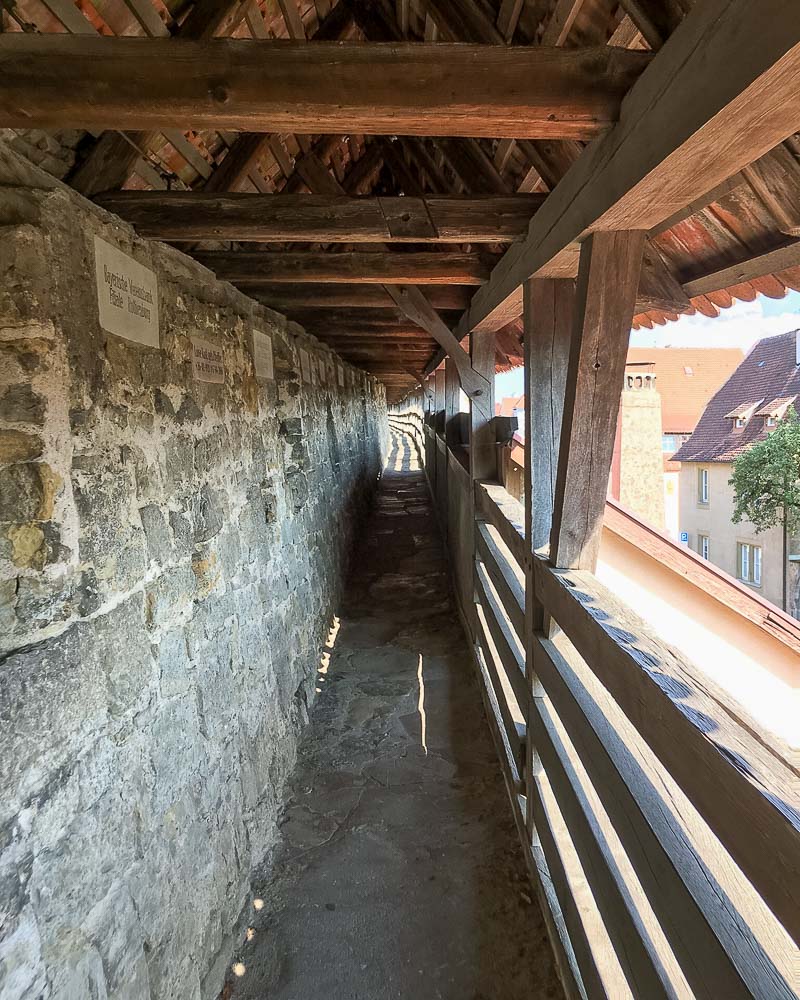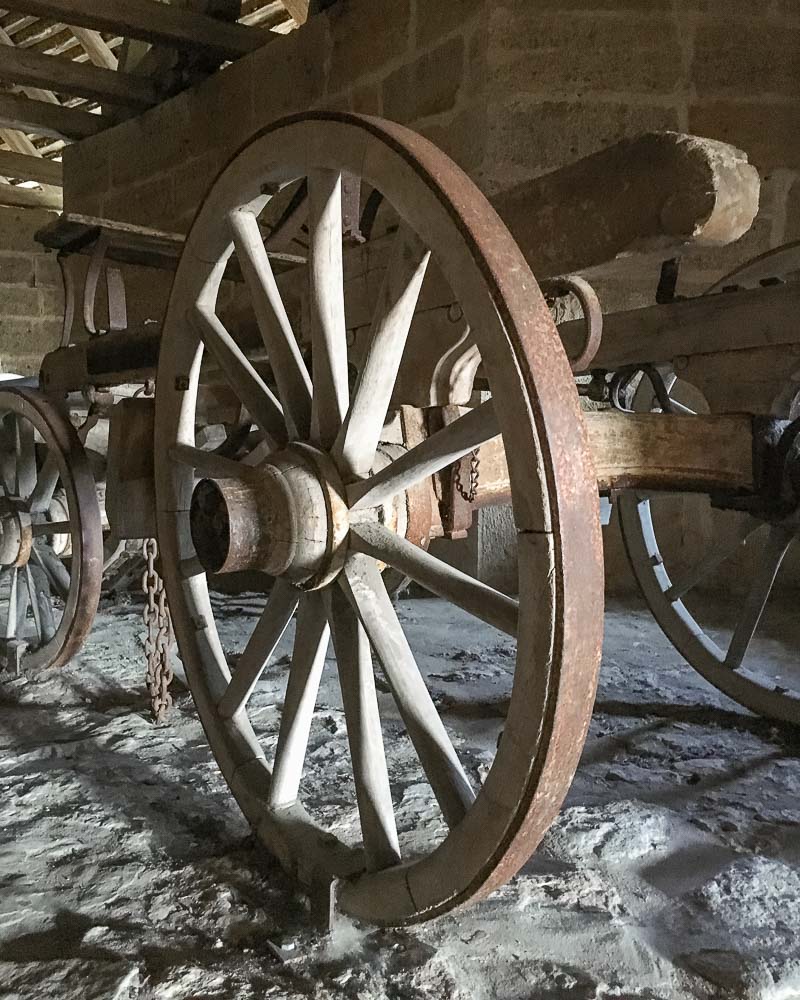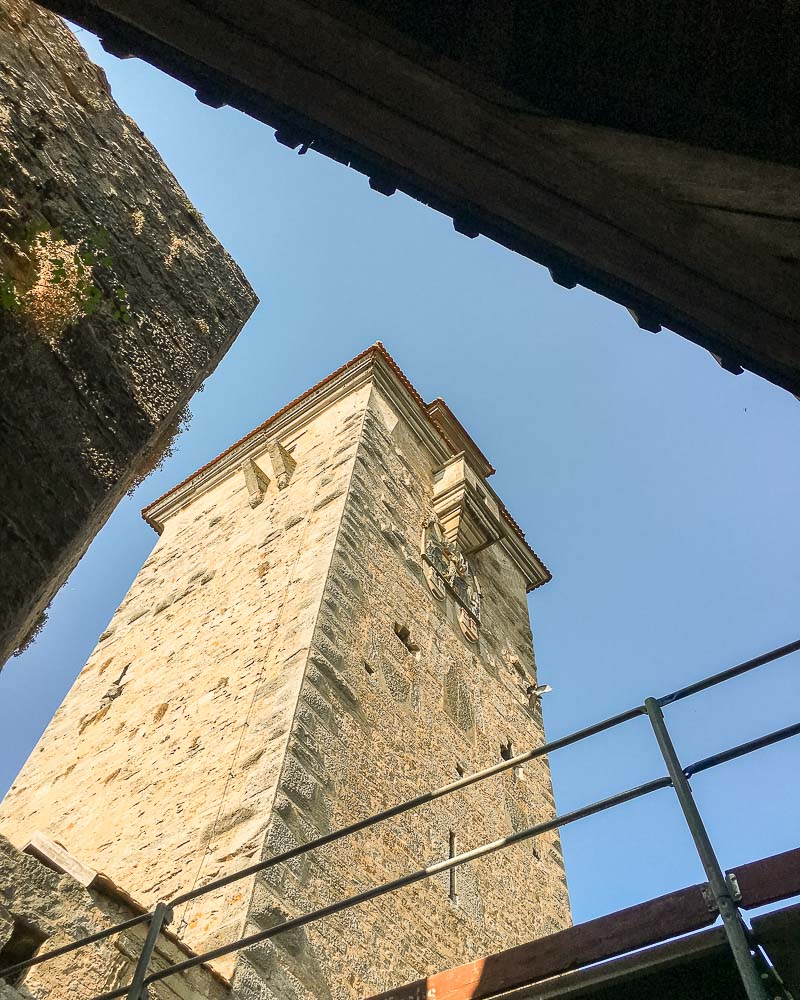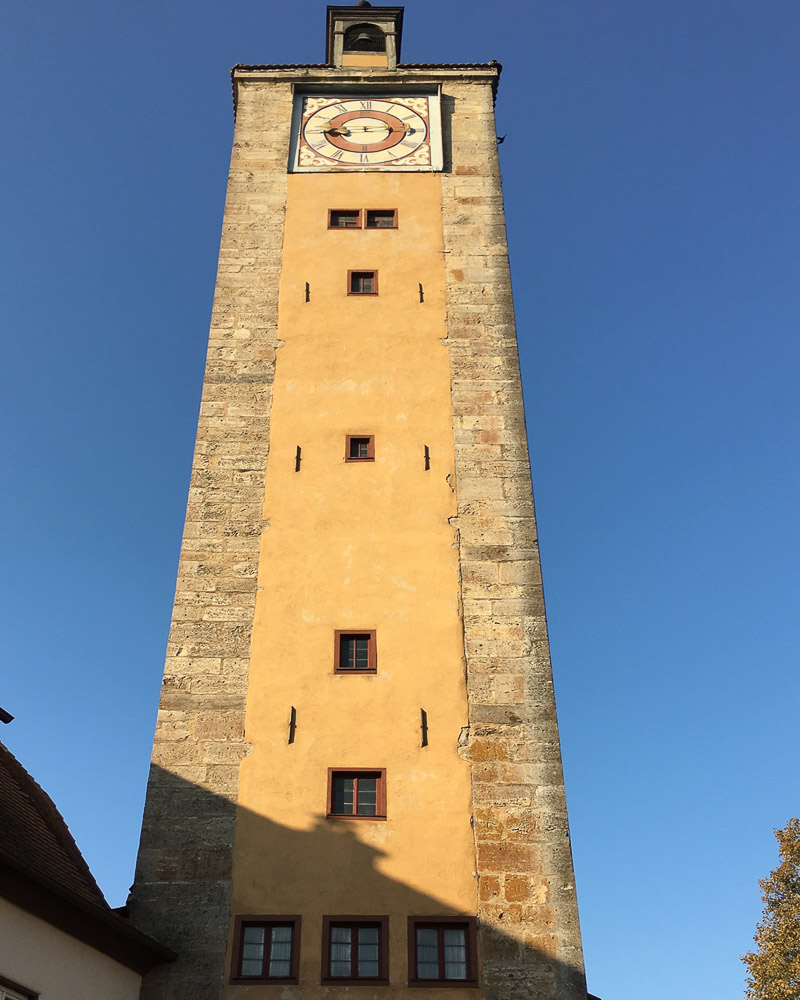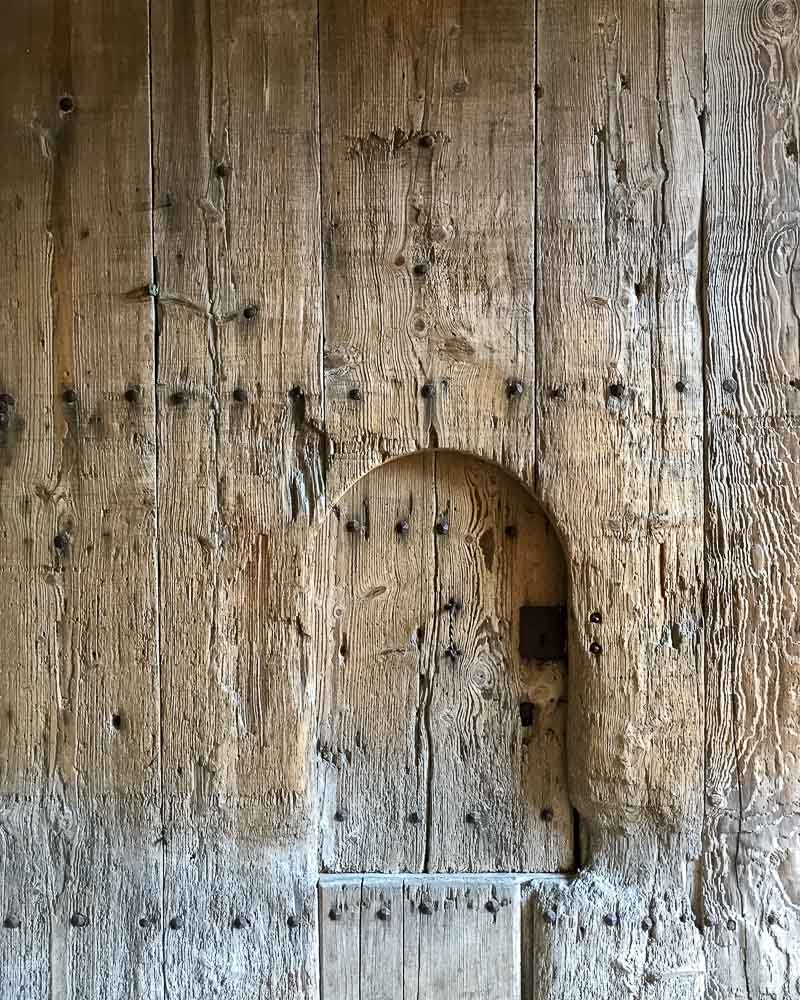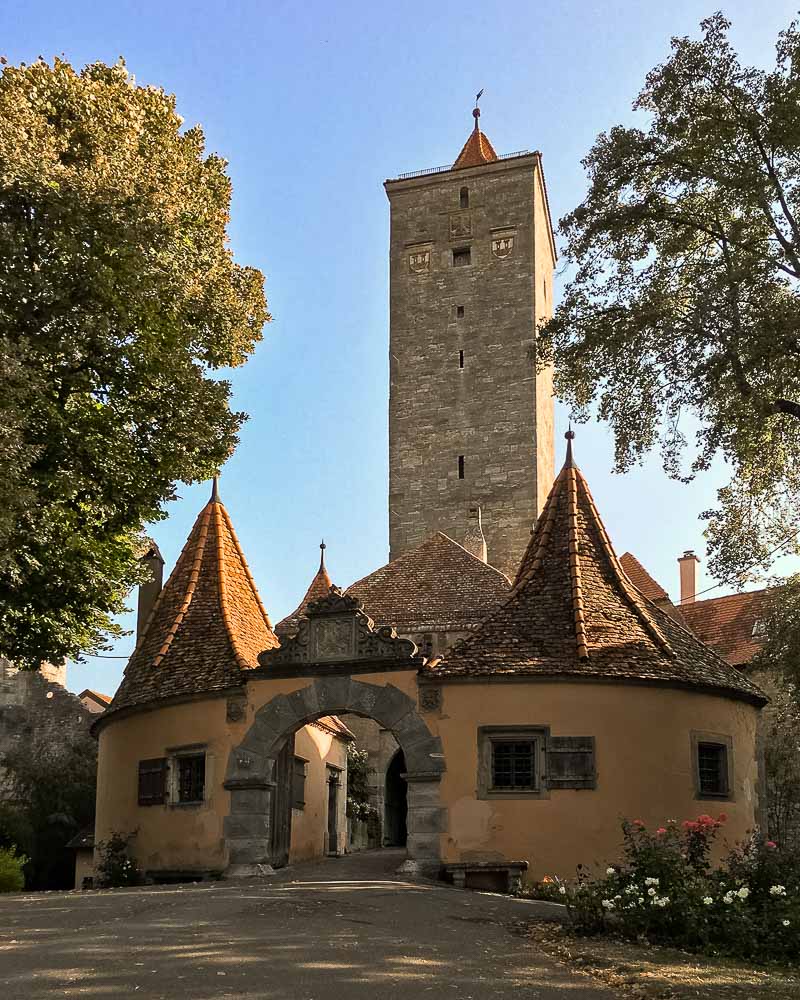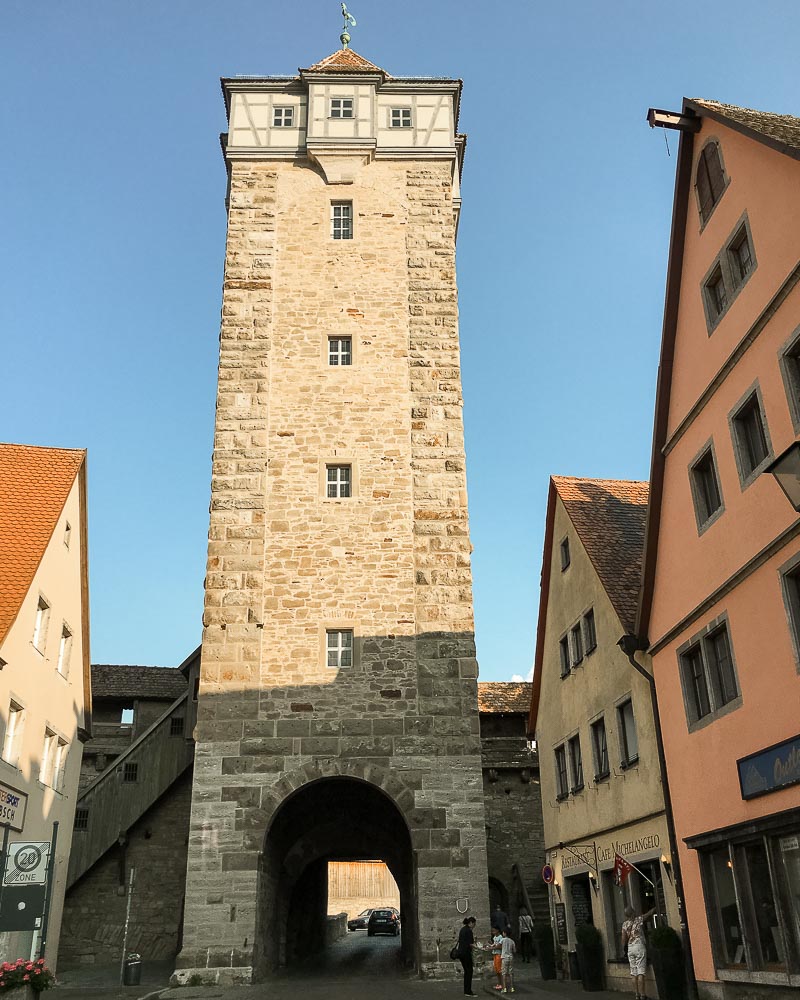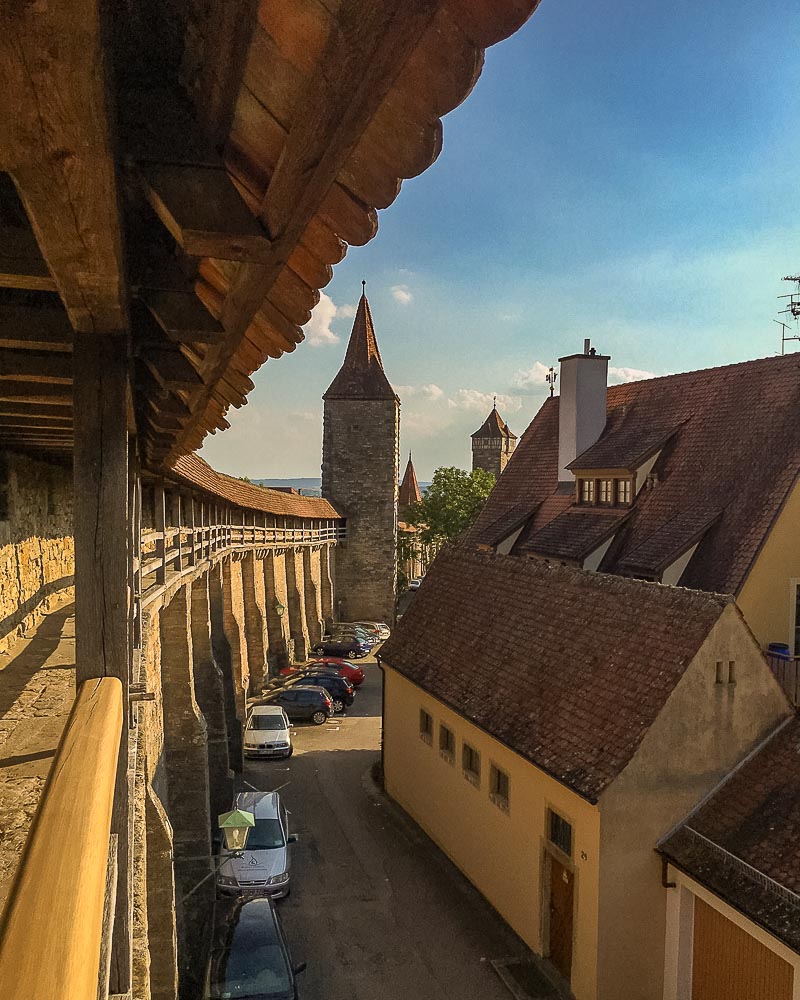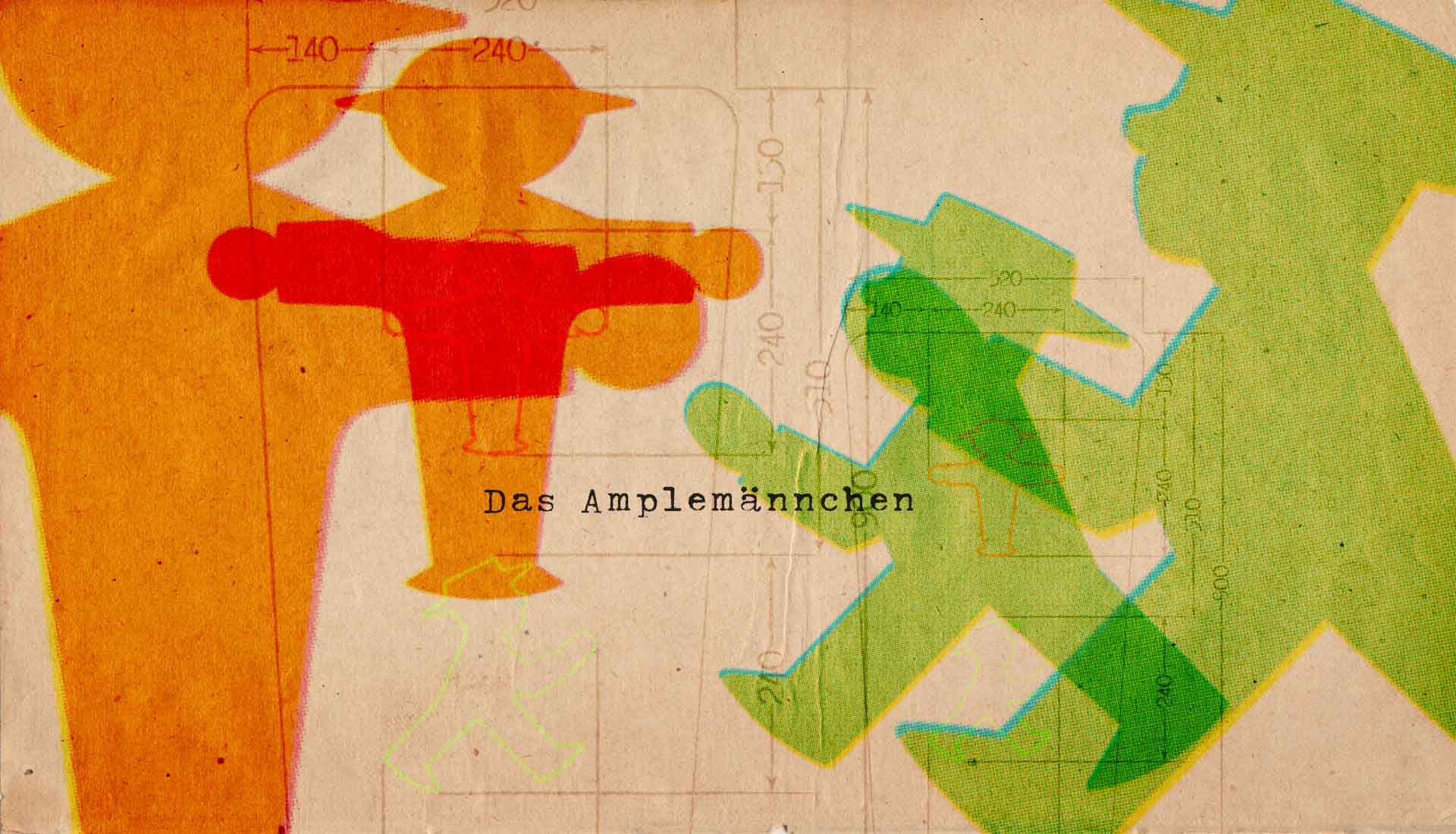Walking the Wall
The altstadt of Rothenburg ob der Tauber is ensconced within walls and six gates: Klingen Gate, Burg Gate, Kobolzell Gate, Spital Bastion, Röder Gate, and Gallows Gate. As the city wall expanded starting in the early 13th century, the number of watchtowers ballooned to 70 (42 of which have been preserved). It is one of only three cities that has its entire wall intact. Come along with me as I walk the wall.
Rödertor (Röder Gate)
My first stop is the impressive Röder Gate (Rödertor) and Röder Tower (Röderturm). As is the custom in many places, roads and gates were often named for the destinations toward which they pointed or travelled. As such, it is said Rödertor derives its name from a small hamlet (called Röder) that once sat just outside Rothenburg in this direction, however, it is also rumored to be named after the the Latin “Curia Rode.” The name is first mentioned around 1307 and is said to be derived from the time of the suburban foundation, when there was a clearing yard in front of the gate, a curia Rode.
Röderturm is the only true observation tower along the town’s wall and has always been an important part of the signaling network – each night, a watchman in the tower would signal to the city center with an all clear signal. In front of the watchtower is the Rödertor with two stone bridges (formerly drawbridges) that lead over the (now dry) moat. The two pointy-roofed structures were used as a toll booth and customs house in the 1300s. The main tower is the oldest part of the gate complex. It dates back to the 13th century, while the half-timbered upper level was added later.

Die Stadtmauer (The City Wall)
The 20-foot-tall city wall is roughly 2.5 miles of medieval ramparts and towers surrounding Rothenburg. Walking up the narrow stone stairs to the single person wide walkway (covered al least) gives one a real Medieval feel. Slits in the wall used to provide lookouts and create vantage points for incoming attacks but now provide glimpses of the modernity outside the city wall.
From the wall, the views of the village are wonderful and, in addition to the gates, there are numerous towers that are connected to the wall and I am able to stroll below them as I walk the wall. One such tower is Rotten Tower – built from 1385-1400 to house serious criminals and is one of the only round city wall towers in Rothenburg. Along the wall are stone plaques with the names of individuals, families, and businesses on them. These are from those who have donated to the rebuilding of the wall after 2,000 feet of the wall was damaged during WWII. When the rebuilding of the wall began in 1950, each sponsorship cost $40 per meter but now costs over $2000 a meter.
Die Spital Tor (Infirmary Gate) & die Spitalbastei (Infirmary Bastion)
My wall walk seems to come to a dead end. Strange, I thought the wall was completely walkable. Oh, I see. This is the next gate located in the Spital quarter in the south of the old town. The figure-eight shaped Spital gate bastion is the most recent part of the city’s fortifications – completed in 1537. The Latin inscription over the gate’s arch says “Pax intrantibus – salus exeuntibus,” meaning “Peace to those who enter, good health to those who depart.”
When the Infirmary was incorporated by the city wall in 1370, a gate was to be built here to serve as the new southern entrance. The defenses of the gate were greatly enhanced in 1586 when the tall gate tower and figure 8 shaped bastion were added. The Bastion has two inner courtyards, seven gates, an upper walkway, and is surrounded by a dry moat.
In 1080 the village of Rothenburg started to move up the hill from its original location on the Tauber River. One of the first buildings up the hill was a small fortress for the Counts of Komburg near the Infirmary. However, when the first city walls were built in the early-1200s, the neighborhood was left outside of the walls. In 1280, a religious order called the Knights of the Hinterland established a hospital to help the sick and poor (called the Holy Ghost Infirmary) and the infirmary was eventually enclosed by the city wall in 1370. Unfortunately, a large fire in the 1500s required most of the hospital complex – except the Holy Ghost Church – be rebuilt.
Der Sauturm (Pig Tower)
Continuing my walk along the wall, I leave the Infirmary and come to a structure bordering on the infirmary grounds. It is called the Pig Tower, which gets its name from the hospital’s pig farming. It was also called the Wildbadersturm, because of its location above the Wildbad. In this area of the infirmary, there used to be the pigsties and the waste was dumped over the wall, where it could be collected by the farmers.
Der Stöberleinsturm (Little Flushing Tower)
The next tower is the beautiful Stöberleinsturm – Little Flushing Tower – and is the is the only remaining tower in Rothenburg to retain its original roof. This tower, which used to be open, bears the four corner turrets, six-sided towers typical of gate towers, between a pyramid roof. Travelers could thus see from a distance where the entrances to the city were – a square tower with a pointed pyramid roof and four hexagonal corner cores, this was the entrance to the city. Originally built in 1080 outside the city walls, the tower and connected building served as a hospital and center for the poor.
In the 17th century, the tower served as a blockhouse for the accommodation of lunatics. It is also known as Hundsturm (Dog Tower) because dogs were used to guard the town moats. The name Stöberlesturm has it origins in a legend that has a mayor – Stöberlein – accused of treason and walled in alive. Today there is an open-air theater below the tower called Stöberlein’s Stage (Stöberleinsbühne) which hosts outdoor plays.
Leaving the Stöberleinsturm behind, the walking route displays Rothenburg in its full glory in the late day sun.

Kobolzellertrum (Kobolzeller Tower)
Leading up from the Tauber River Valley, the Kobolzeller Gate has numerous extra layers of protection from unwanted visitors. Following the Earthquake of 1356, the gate was expanded into a 4 gate system with two towers. The tower was named after the tiny Kobolzell settlement that once lay below Rothenburg. Today only the Kobolzeller Church, the Double Bridge, Lords Mill Inn, and a few residential houses remain from the settlement.
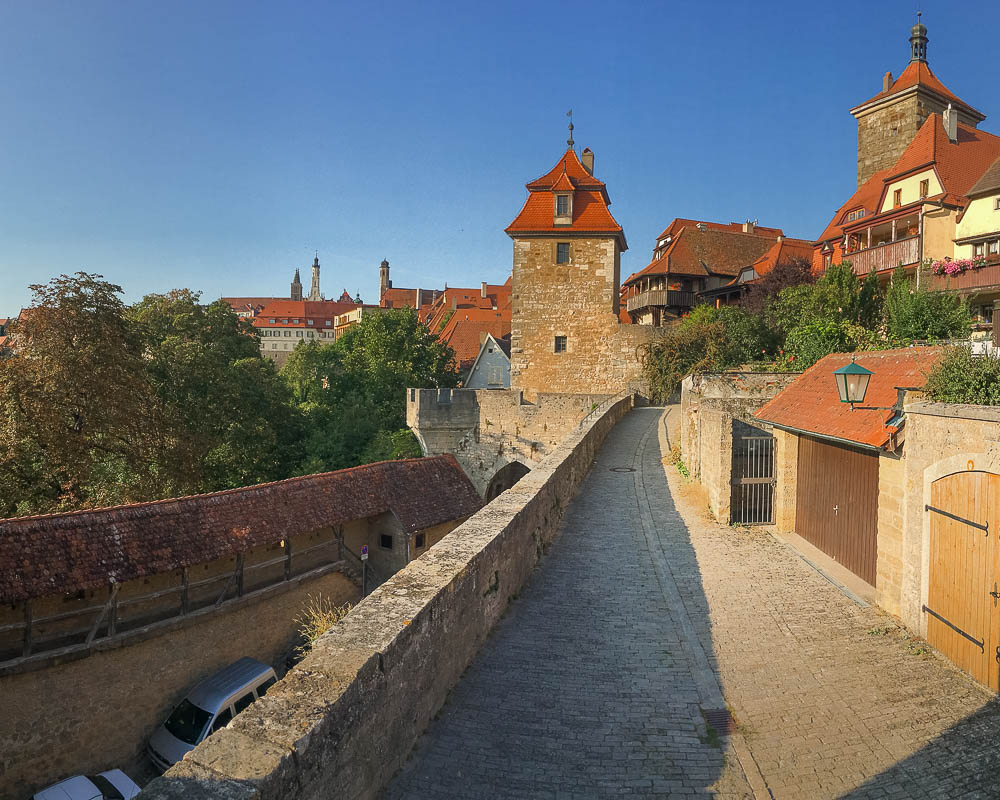
Burgtor & Burgturm (Castle Gate & Tower)
Following the wall, I come to the Castle Gate at the entrance of the city and the (now gone) Hohenstaufen Castle (or vice versa depending on your point of view). Whereas the Fürbringer Barn Gate was the original entrance into the castle grounds, traffic shifted to Castle Gate, which connected to the grounds to the Market Square. After Castle Hohenstaufen was destroyed in the earthquake of 1356, they needed to enhance their defense on the West side of town and decided to super-size the Castle Gate (completed in 1460), adding the town’s tallest watchtower, a drawbridge, and other protective measures. Two small gatehouses were built in front of the Castle Gate to help funnel in traffic and thwart would-be attackers.
In Medieval times, all of the city gates were locked at sundown so you would have to pay a fine at the gatehouse to get in after dark. You would also have to enter a special Eye-of-the-Needle door with a small opening only big enough for one person – without armor – to enter at a time, known as the manhole. The current wooden manhole door dates back to 1555 and was the only way into town if you missed curfew at dark when the gates were locked.
Just inside the gatehouses, in the middle of the gate is the decorative Pitch Nose Mask (Pechnase) where hot oil or tar would be poured out on attackers. On either sides of the mask, there are two large slots where chains were fastened to raise the gate’s drawbridge.
Burgeck (Castle Corner)
The little round tower in the castle garden of Rothenburg ob der Tauber, also known as the “Schneiderstürmle”, takes its name from its location, the connection of the castle wall to the ring wall of the town and also from the fact that the tailors (Schneider) used to keep watch here.
The Castle Garden I had explored the day before and I am running out of time. I seed to drive to my next stop – one final look at the Burgtor and I continue on my walk.

Würzburger Tor (Würzburg Gate)
This square gate tower spans the Galengasse (Gallows Alley) – so named because the road lead to the gallows located outside the village in Little-Head Meadow (Kleine Kopfwiese). (The gallows had been in use until the mid-1800s.) As such, the tower is also appropriately called the Galentor or Gallows Gate. Built in 1388 during the largest expansion of the city wall, it was damaged in a fire in 1400 but quickly repaired. It was raised in the 18th century but restored after the destruction of WWII and it now sits at the highest point of the town fortification. Square artillery posts along this wall section – once as many as 12 – helped strengthen this section of the wall which had been the weakest. Furthermore, an additional five watchtowers were added in 1600.
Just inside the gate stands a house (No. 54) with an inscription in old blackletter. It is a Sinnspruch (an adage) that was cultivated by German poets for a brief period of time around the 17th and 18th centuries. This is one of several around the city and marks the way to the place of execution. I am unsure of the meaning (Elm would be a person’s name) and seems to be a historical reference. However, as this is supposed to be an adage, I am wondering if it has something to do with pride. A little farther, a gallows symbol is embedded in the street pavement, signifying that you are following the right way to the gallows.
The long Elm from Ingolstadt... a knight proudly on horseback... he was in front of the Galgentor... beheaded with the sword.
I am hot, a bit sunburned, and very, very tired. I eschew walking the last small part of the wall – partly because of my tiredness and partly because I want to see two museums that I should just make if I hurry. I see one of my destinations ahead…
Alas, I am too late to enter – I will have to add that to the list for tomorrow’s tour. As I walk back through the town, I see that many of the people have retired to dinner or, perhaps, headed home. I believe that is an excellent decision – I take my time walking back to the hotel – enjoying the long shadows from the sinking sun and the the emptiness of the village. Tomorrow, my adventure continues.







